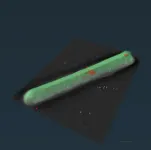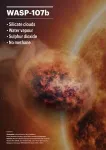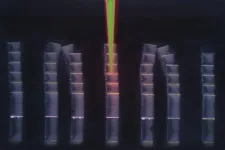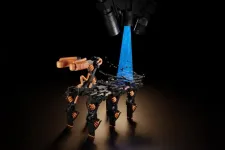(Press-News.org) Iron storage “spheres” inside the bacterium C. diff — the leading cause of hospital-acquired infections — could offer new targets for antibacterial drugs to combat the pathogen.
A team of Vanderbilt researchers discovered that C. diff (Clostridioides difficile) produces the spheres, called ferrosomes, and that these structures are important for infection in an animal model. The findings, reported Nov. 15 in the journal Nature, are also a rare demonstration of a membrane-bound structure inside a pathogenic bacterium.
Bacteria have long been thought not to contain organelles (such as a nucleus, mitochondria and other specialized structures) like eukaryotic cells, but that biological dogma appears to be incorrect.
“The emerging idea that bacteria do compartmentalize biochemical processes in a way similar to eukaryotic cells really flips the field of microbiology on its head,” said Eric Skaar, PhD, MPH, the Ernest W. Goodpasture Professor of Pathology and director of the Vanderbilt Institute for Infection, Immunology, and Inflammation.
Skaar, co-corresponding author Qiangjun Zhou, PhD, assistant professor of Cell and Developmental Biology, and their colleagues were intrigued by findings reported several years ago that some environmental bacteria produce iron-containing ferrosomes.
They knew that the genes in these bacteria were conserved in C. diff and other anaerobic bacteria (bacteria that die in the presence of oxygen), and they set out to determine if C. diff produces ferrosomes to manage its need for iron. Like all living organisms, C. diff requires iron to survive and grow. Skaar and his team have focused on how pathogens like C. diff acquire iron and other metals, with a goal of finding new pathways that could be exploited to “starve” pathogens of essential nutrients.
C. diff causes about 500,000 infections and more than 29,000 deaths in the United States each year, according to the Centers for Disease Control and Prevention, and treatment options are limited. People taking antibiotics that disrupt the healthy microbes in the gut are at increased risk for C. diff infection, which causes diarrhea and colitis. New strategies for treating this urgent public health threat are needed, Skaar said.
To look for iron inside C. diff, the researchers first drew on expertise and resources in the Vanderbilt Institute of Nanoscale Science and Engineering (VINSE).
“The best way to look for the accumulation of elements in a small space like a cell is with a method called STEM-EDS, which has not commonly been used for biological samples,” Skaar said. “We were fortunate to have access to a STEM-EDS instrument and collaborators at VINSE, and we quickly proved that there was an accumulation of iron ‘dots’ within the bacterium.”
Co-first authors Hualiang Pi, PhD, and Rong Sun, PhD, led studies to show that those iron dots represented organelles that were important to C. diff infection.
Pi and Skaar’s team found that two genes (fezA and fezB), which are similar to those in environmental bacteria, were required for ferrosome formation. Using C. diff bacteria missing these genes, they showed that ferrosomes are required for C. diff to fully colonize and cause disease in an animal model. They found that ferrosomes were even more important for C. diff infection in a model of inflammatory bowel disease, demonstrating that these iron-containing structures help the bacterium combat “nutritional immunity” — the host response of producing proteins to bind iron and attempt to starve the pathogen.
Sun and Zhou’s team used cryogenic electron microscopy (cryo-EM) and cryo-tomography to show that the ferrosome structures were encased in a membrane, classifying them as organelles.
Skaar noted that “Vanderbilt’s unique geography” — the proximity of experts in engineering, cell biology and the Medical Center — and specialized tools for STEM-EDS and cryo-EM made the research possible.
The results “establish ferrosome formation and all the factors involved in ferrosome formation as potential targets for new antibacterial drugs against an important infectious disease,” Skaar said. “Anytime we find new factors involved in host-pathogen interactions and show that they’re important for infection, that opens entirely new opportunities to make classes of antibacterial drugs that have not existed before. That is especially important in the face of rising antimicrobial resistance that we’re seeing globally.”
In future studies, the researchers plan to explore how ferrosomes are formed, whether other gut pathogens produce ferrosomes, and whether these structures might be shared in the gut as a source of iron. Skaar is also particularly interested in pursuing the emerging area of bacterial organelles.
“We think our study is a rare demonstration of an organelle in a pathogenic bacterium,” he said. “Now we want to know if there are other subcellular compartments in bacteria that we’re interested in that could teach us about how these cells perform various physiologic processes.”
Pi, a former postdoctoral fellow at Vanderbilt, is now an assistant professor of Microbial Pathogenesis at Yale School of Medicine. Sun is a postdoctoral fellow in Cell and Developmental Biology. Other authors of the Nature paper include James McBride, PhD, Angela Kruse, PhD, Katherine Gibson-Corley, DVM, PhD, Evan Krystofiak, PhD, Maribeth Nicholson, MD, MPH, and Jeffrey Spraggins, PhD. The research was supported by grants from the National Institutes of Health (R01AI073843, R01AI164587, U19AI174999, R01AI13858, R00MH113764, F32AI161860, K99AI168483 and K23AI156132).
The DOI number for this paper is 10.1038/s41586-023-06719-9.
END
Novel C. diff structures are required for infection, offer new therapeutic targets
2023-11-15
ELSE PRESS RELEASES FROM THIS DATE:
UK diabetes prevention program may have global impact
2023-11-15
A nationwide programme to reduce the risk of developing diabetes in the UK is proven beyond reasonable doubt to work, a new study reveals.
The positive effects observed in the NHS Diabetes Prevention Programme – the largest such project in the world helping people across the UK to lose weight and control their blood sugar levels – may have relevance globally for tackling the diabetes epidemic.
The Diabetes Prevention Programme (NHS DPP) in England referred adults with high risk of developing diabetes to lifestyle counselling for losing weight, encouraging physical activity, and other ...
James Webb Space Telescope detects water vapor, sulfur dioxide and sand clouds in the atmosphere of a nearby exoplanet
2023-11-15
A team of European astronomers, co-led by researchers from the Institute of Astronomy, KU Leuven, used recent observations made with the James Webb Space Telescope to study the atmosphere of the nearby exoplanet WASP-107b. Peering deep into the fluffy atmosphere of WASP-107b they discovered not only water vapour and sulfur dioxide, but even silicate sand clouds. These particles reside within a dynamic atmosphere that exhibits vigorous transport of material.
Astronomers worldwide are harnessing the advanced capabilities of the Mid-Infrared Instrument (MIRI) aboard the James Webb Space Telescope (JWST) to conduct groundbreaking observations of exoplanets – planets orbiting stars ...
New laser setup probes metamaterial structures with ultrafast pulses
2023-11-15
Metamaterials are products of engineering wizardry. They are made from everyday polymers, ceramics, and metals. And when constructed precisely at the microscale, in intricate architectures, these ordinary materials can take on extraordinary properties.
With the help of computer simulations, engineers can play with any combination of microstructures to see how certain materials can transform, for instance, into sound-focusing acoustic lenses or lightweight, bulletproof films.
But simulations can only take a design so far. To know for sure whether a metamaterial will stand up to expectation, physically testing them is a must. But there’s been no reliable way to push and pull ...
Pulling the plug on brain injury: manipulating fluid flows could save lives, improve recovery post-TBI
2023-11-15
Cerebral edema, the dangerous brain swelling that occurs after traumatic brain injury (TBI), can increase risk of death tenfold and significantly worsen prospects for recovery in brain function. In extreme cases, surgeons will remove a portion of the skull to relieve pressure, but this has significant risks and is not viable for the vast majority of TBI cases. Physicians have very few tools at their disposal that are effective in treating cerebral edema, which is one of the leading causes of in-hospital deaths, and is associated with long-term neurological disability.
New ...
Completion of recommended tests and referrals in telehealth vs in-person visits
2023-11-15
About The Study: The findings of this study suggest that rates of completion for 4,133 diagnostic tests and referrals (colonoscopies, cardiac stress tests, and dermatology referrals) were low for all visit types but worse when ordered during telehealth visits. Failure to close diagnostic loops presents a patient safety challenge in primary care that may be of particular concern during telehealth encounters.
Authors: Maelys J. Amat, M.D., M.B.A., of Beth Israel Deaconess Medical Center in Boston, is the corresponding author.
To ...
Neighborhood disadvantage and autism spectrum disorder in a population with health insurance
2023-11-15
About The Study: Children residing in more disadvantaged neighborhoods at birth had higher likelihood of autism spectrum disorder (ASD) diagnosis in a study that included 318,000 children with health insurance. Future research is warranted to investigate the mechanisms behind the neighborhood-related disparities in ASD diagnosis, alongside efforts to provide resources for early intervention and family support in communities with a higher likelihood of ASD.
Authors: Daniel A. Hackman, Ph.D., of the University of Southern California in Los Angeles, is the corresponding author.
To access the embargoed study: Visit our For The Media website at this link https://media.jamanetwork.com/
(10.1001/jamapsychiatry.2023.4347)
Editor’s ...
Roaming seabirds need ocean-wide protection
2023-11-15
Seabirds roam far and wide in the Indian Ocean – so they need ocean-wide protection, new research shows.
All other oceans are known to contain “hotspots” where predators including seabirds feast on prey.
But the new study – by a team including Exeter, Heriot-Watt and Réunion universities, and ZSL – found no such concentrations in the Indian Ocean.
With seabirds facing numerous threats due to human activity, their survival depends on protecting the open ocean.
“Efforts are being made to protect key breeding colonies, but until now little was known about where Indian Ocean seabirds ...
New process for screening old urine samples reveals previously undetected ‘designer drugs’
2023-11-15
Researchers from the University of B.C. and the BC Provincial Toxicology Centre (BCPTC) have developed a more efficient way to find out which new ‘designer drugs’ are circulating in the community.
In a study published today in Analytical Chemistry, they showed how high-resolution mass spectrometry can be used to analyze urine samples at scale and uncover molecules from emerging designer drugs that have been missed by conventional testing.
The approach can support public health and safety by enabling swift identification of new substances, potentially saving lives and guiding timely clinical responses to drug-related ...
This 3D printer can watch itself fabricate objects
2023-11-15
With 3D inkjet printing systems, engineers can fabricate hybrid structures that have soft and rigid components, like robotic grippers that are strong enough to grasp heavy objects but soft enough to interact safely with humans.
These multimaterial 3D printing systems utilize thousands of nozzles to deposit tiny droplets of resin, which are smoothed with a scraper or roller and cured with UV light. But the smoothing process could squish or smear resins that cure slowly, limiting the types of materials that can be used.
Researchers from MIT, the MIT spinout Inkbit, and ETH Zurich have developed a new 3D inkjet printing system that works ...
A new kind of magnetism
2023-11-15
For a magnet to stick to a fridge door, inside of it several physical effects need to work together perfectly. The magnetic moments of its electrons all point in the same direction, even if no external magnetic field forces them to do so. This happens because of the so-called exchange interaction, a combination of electrostatic repulsion between electrons and quantum mechanical effects of the electron spins, which, in turn, are responsible for the magnetic moments. This is common explanation for the fact that certain materials like ...







